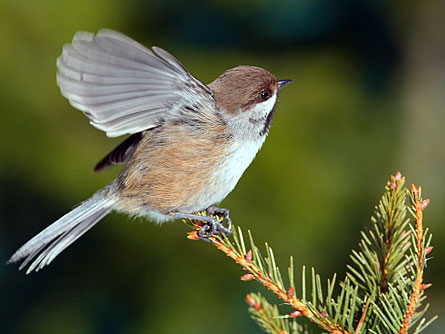PHILADELPHIA — When trees fall in the forest, unheard or not, they may change the shape of bird wings.

As logging whittled away at Canada’s vast boreal forest during the past century, bird species that frequent mature woodlands developed somewhat pointier wing tips, says André Desrochers of the Center for Forest Research at Laval University in Québec City.
During the same period, forests expanded in New England. Mature-woodland species there trended toward rounder wing tips, he reported August 13 in Philadelphia at a meeting of the American Ornithologists’ Union.
Sharper points on wings typically prove more efficient than blunter shapes during sustained flight, Desrochers says. But previous research on wing shapes and flight also found a cost for those points. On tight maneuvers threading 3-D mazes of branches, pointy wings lose out to rounder ones.
Several other studies have noted wing-shape differences within the same species if some populations migrate and some don’t. House finches in the eastern United States that follow the seasons, for example, tend toward sharper wings than western, couch-potato house finches.
Desrochers said he began to wonder whether human activities that leave forests in fragments might influence wings the same way migratory lifestyles do. Loggers chewing away at the conifer forest that once blanketed most of Canada has meant that birds now fly farther than their ancestors to find prime territories and mates. Feeding the relentless gaping mouths of chicks in tattered forests also meant longer commutes, and all this extra flying might change the balance of trade-offs for wing shape.
To see if a hundred years of landscape change could make a difference, Desrochers measured wings of 21 species of forest birds. He included species that are typical in early stages of forest growth and those more common in mature woodlands. Measuring a total of 851 specimens, he worked his way through the collections of the Canadian Museum of Nature in Gatineau, Quebec, and the Cornell Lab of Ornithology in Ithaca, N.Y.
Mature-woodland species showed the clearest change in pointiness regardless of body size, Desrochers said. During the past century, their long wing feathers, or primary feathers, overall gained about 2.23 millimeters on average. That uptick roughly matches the magnitude of differences between sexes. For example, a female boreal chickadee’s wing today is about the length of a male’s in 1900, he said.
Desrochers also included more southerly species on his list, such as the scarlet tanager and hooded warbler. These birds had experienced a very different century. The landscape of New England, deforested during previous years, rebounded into green woodland again. And here, Desrochers found a trend back toward rounder wing tips. The eight mature-woodland species he studied typically had lost, on average, some 2.37 millimeters on those long primary feathers.
These species aren’t passive victims of environmental change, Desrochers said. As bird species face new challenges, they respond to the extent they can. “Birds are not like sitting ducks,” he said.
“It’s surprising that there’s so much change so fast,” said ornithologist David Winkler, who studies physiological and evolutionary ecology at Cornell University.
He also noted that the study, which didn’t look at genetic evidence, doesn’t explicitly address whether the wings change by evolution or by some other process. Winkler said that in observing changes and invoking evolution, “we need to be careful.”
Desrochers responds that his approach can’t prove the wing change is genetic. He points out, however, that research has found that inheritance strongly influences wing length, and he argues that rapid evolution is the most straightforward explanation for his findings.






